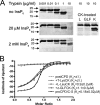Structural and molecular mechanism for autoprocessing of MARTX toxin of Vibrio cholerae at multiple sites
- PMID: 19620709
- PMCID: PMC2785344
- DOI: 10.1074/jbc.M109.025510
Structural and molecular mechanism for autoprocessing of MARTX toxin of Vibrio cholerae at multiple sites
Abstract
The multifunctional autoprocessing repeats-in-toxin (MARTX) toxin of Vibrio cholerae causes destruction of the actin cytoskeleton by covalent cross-linking of actin and inactivation of Rho GTPases. The effector domains responsible for these activities are here shown to be independent proteins released from the large toxin by autoproteolysis catalyzed by an embedded cysteine protease domain (CPD). The CPD is activated upon binding inositol hexakisphosphate (InsP(6)). In this study, we demonstrated that InsP(6) is not simply an allosteric cofactor, but rather binding of InsP(6) stabilized the CPD structure, facilitating formation of the enzyme-substrate complex. The 1.95-A crystal structure of this InsP(6)-bound unprocessed form of CPD was determined and revealed the scissile bond Leu(3428)-Ala(3429) captured in the catalytic site. Upon processing at this site, CPD was converted to a form with 500-fold reduced affinity for InsP(6), but was reactivated for high affinity binding of InsP(6) by cooperative binding of both a new substrate and InsP(6). Reactivation of CPD allowed cleavage of the MARTX toxin at other sites, specifically at leucine residues between the effector domains. Processed CPD also cleaved other proteins in trans, including the leucine-rich protein YopM, demonstrating that it is a promiscuous leucine-specific protease.
Figures







References
Publication types
MeSH terms
Substances
Associated data
- Actions
Grants and funding
LinkOut - more resources
Full Text Sources
Other Literature Sources
Molecular Biology Databases

